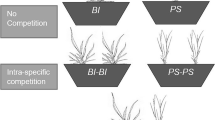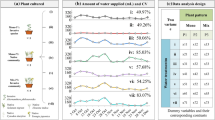Abstract
Understanding and predicting possible responses of grassland species to global change is of important meaning for adapting grassland management to a changed and changing environment. A laboratory clipping experiment was conducted to examine the interspecific responses in an ecological context of competition and environmental changes. Festuca rubra and Trifolium pratense, either in monoculture or two- and three-species mixtures, were grown in three environmental combinations (ambient and increased temperature, repetitive N supply, and simulated acid rain), respectively. After a growth time of three months, plants were clipped at the height of 1.0 cm above soil surface. Plant height and aboveground biomass prior clipping, and survival rate and regrowth (height and biomass) after clipping were analyzed. F. rubra and T. pratense responded differently in compensatory growth and competition intensity to environmental change and co-existing species. The differences in their physiological and ecological traits may account for species-dependent responses. The present study emphasizes that predicting the plant assemblage response in the face of global change requires in understanding the integrating effects of abiotic and biotic factors.
Similar content being viewed by others
Abbreviations
- MonoF/MonoT:
-
Monoculture of Festuca rubra or Trifolium pratense
- MixFT:
-
Mixed culture of F. rubra and T. pratense
- MixFTO:
-
Mixed culture of F. rubra, T. pratense, and Oenothera biennis
- MixFTH:
-
Mixed culture of F. rubra, T. pratense and Hieracium pilosella
- T0N0W6.0 :
-
ambient temperature + no additional N applied + watering at pH6.0
- T+N+W6.0 :
-
increased temperature + N-addition + watering at pH6.0
- T+N+W4.0 :
-
increased temperature + N-addition + watering at pH 4.0
References
Augustine D.J. & MacNaughton S.J. 1998. Ungulate effects on the functional species composition of plant communities: herbivore selectivity and plant tolerance. J. Wildlife Manag. 62: 1165–1183.
Belsky A.J. 1986. Does herbivory benefit plants? A review of the evidence. Am. Nat. 127: 870–892.
Bullock J.M., Franklin J., Stevenson M.J., Silvertown J., Coulson S.J., Gregory S.J. & Tofts R. 2001. A plant trait analysis of responses to grazing in a long-term experiment. J. Appl. Ecol. 38: 253–267.
Carlsson G. & Huss-Danell K. 2003. Nitrogen fixation in perennial forage legumes in the field. Plant Soil 253: 353–372.
Chapin F.S.III & McNaughton S.J. 1989. Lack of compensatory growth under phosphorus deficiency in grazing-adapted grasses from the Serengeti Plains. Oecologia 79: 551–557.
Coley P.D., Bryant J.P. & Chapin F.S.III. 1985. Resource availability and plant antiherbivore defense. Science 230: 895–899.
Conover W.J. & Iman R.L. 1981. Rank transformations as a bridge between parametric and nonparamentric statistics. Am. Stat. 35: 124–133.
Crawley M.J. 1997. Plant Ecology 2nd edn. Blackwell Science, Oxford.
Dunnett N.P. & Grime J.P. 1999. Competition as an amplifier of short-term vegetation responses to climate: an experimental test. Funct. Ecol. 13: 388–395.
Ferraro D.O. & Oesterheld M. 2002. Effect of defoliation on grass growth: a quantitative review. Oikos 98: 125–133.
Fynn R.W.S., Morris C.D. & Kirkman K.P. 2005. Plant strategies and trait trade-offs influence trends in competitive ability along gradients of soil fertility and disturbance. J. Ecol. 93: 384–394.
Gonzalez B., Boucaud J., Salette J., Langlois J. & Duyme M. 1989. Changes in stubble carbohydrate content during regrowth of defoliated perennial ryegrass (Lolium perenne L.) on two nitrogen levels. Grass Forage Sci. 44: 411–415.
Goldberg D.E. & Werner P.A. 1983. Equivalence of competitors in plant communities: a null hypothesis and a field experimental approach. Am. J. Bot. 70: 1098–1104.
Hara T. 1993. Effects of variation in individual growth on plant species coexistence. J. Veg. Sci. 4: 409–416.
Hartley S.E. & Amos L. 1999. Competitive interactions between Nardus stricta L. and Calluna vulgaris (L.) Hull: the effect of fertilizer and defoliation on above- and belowground performance. J. Ecol. 87: 330–340.
Hartley S.E. & Mitchell R.J. 2005. Manipulation of nutrients and grazing levels on heather moorland: changes in Calluna dominance and consequences for community composition. J. Ecol. 93: 990–1004.
Hilbert D.W., Swift D.M., Detling J.K. & Dyer M.I. 1981. Relative growth rates and the grazing optimization hypothesis. Oecologia 51: 14–18.
Houdijk A.L.F.M., Verbeek P.J.M., van Dijk H.F.G. & Roelofs J.G.M. 1993. Distribution and decline of endangered herbaceous heathland species in relation to the chemical composition of the soil. Plant Soil. 148: 137–143.
IPCC 2007: Summary for policymakers, pp. 2–18. In: Solomon S., Qin D., Manning M., Chen Z., Marquis M., Averyt K.B., Tignor M. & Miller H.L. (eds), Climate Change 2007: The Physical Science Basis. Contribution of Working Group I to the Fourth Assessment Report of the Intergovernmental Panel on Climate Change. Cambridge University Press, Cambridge, United Kingdom and New York, NY, USA.
Jarvis S.C. & Macduff J.H. 1989. Nitrate nutrition of grasses from steady-state supplies in flowing solution culture following nitrate deprivation and/or defoliation. I. Recovery of uptake and growth and their interactions. J. Exp. Bot. 40: 965–975.
Lee T.D. & Bazzaz F.A. 1980. Effects of defoliation and competition on growth and reproduction in the annual plant Abutilon theophrasti. J. Ecol. 68: 813–821.
Lestienne F., Thornton B. & Gastal F. 2006. Impact of defoliation intensity and frequency on N uptake and mobilization in Lolium perenne. J. Exp. Bot. 57: 997–1006.
Li M.H., Kräuchi N. & Gao S.P. 2006. Global warming: can existing reserves really preserve current levels of biological diversity? J. Integr. Plant Biol. 48: 255–259.
Louda S.M., Keeler K.H. & Holt R.D. 1990. Herbivore influences on plant performance and competitive interactions, pp. 414–444. In: Grace J.B. & Tilman D. (eds), Perspectives on Plant Competition. Academic Press, San Diego.
Magda D., Duru M., Huguenin J. & Gleizes B. 2006. Impact of shading and cutting on the demography and composition of Mimosa pudica L., a ligneous weed species of tropical grasslands. Grass Forage Sci. 61: 89–96.
Markham J.H. & Chanway C.P. 1996. Measuring plant neighbour effects. Funct. Ecol. 10: 548–549.
McNaughton S.J. 1983. Compensatory plant growth as a response to herbivory. Oikos 40: 329–336.
McNaughton S.J. 1992. Laboratory-simulated grazing: interactive effects of defoliation and canopy closure on Serengeti grasses. Ecology 73: 170–182.
Morvan-Bertrand A., Pavis N., Boucaud J. & Prud’homme M.P. 1999. Partitioning of reserve and newly assimilated carbon in roots and leaf tissues of Lolium perenne during regrowth after defoliation: assessment by 13C steady-state labelling and carbohydrate analysis. Plant Cell Environ. 22: 1097–1108.
Painter E.L. & Detling J.K. 1981. Effects of defoliation on net photosynthesis and regrowth of western wheatgrass. J. Range Manage. 34: 68–71.
Parsons A.J., Leafe E.L., Collett B. & Stiles W. 1983. The physiology of grass production under grazing. I. Characteristics of leaf and canopy photosynthesis of continuously-grazed swards. J. Appl. Ecol. 20: 117–126.
Roem W.J. & Berendse F. 2000. Soil acidity and nutrient supply ratio as possible factors determining changes in plant species diversity in grassland and heathland communities. Biol. Conserv. 92: 151–161.
Sala O.E., Chapin F.S. III, Armesto J.J., Berlow R., Bloomfield J., Dirzo R., Huber-Sanwald E., Huenneke L.F., Jackson R.B., Kinzig A., Leemans R., Lodge D., Mooney H.A., Oesterheld M., Poff N.L., Sykes M.T., Walker B.H., Walker M. & Wall D.H. 2000. Global biodiversity scenarios for the year 2100. Science 287: 1770–1774.
Schwinning S. & Parsons A.J. 1996. Analysis of the coexistence mechanisms for grasses and legumes in grazing systems. J. Ecol. 84: 799–813.
Shaw M.R., Zavaleta E.S., Chiariello N.R., Cleland E.E., Mooney H.A. & Field C.B. 2002. Grassland responses to global environmental changes suppressed by elevated CO2. Science 298: 1987–1990.
van Der Wal R., Egas M., van Der Veen A. & Bakker J. 2000. Effects of resource competition and herbivory on plant performance along a natural productivity gradient. J. Ecol. 88: 317–330.
van Staalduinen M.A. & Anten N.P.R. 2005. Differences in the compensatory growth of two co-occurring grass species in relation to water availability. Oecologia 146: 190–199.
Vitousek P.M., Aber J.D., Howarth R.W., Likens G.E., Matson P.A., Schindler D.W., Schlesinger W.H. & Tilman D.G. 1997. Human alteration of the global nitrogen cycle: sources and consequences. Ecol. Appl. 7: 737–750.
Zavaleta E.S., Shaw M.R., Chiariello N.R., Mooney H.A. & Field C.B. 2003. Additive effects of simulated climate changes, elevated CO2, and nitrogen deposition on grassland diversity. P. Natl. Acad. Sci. USA 100: 7650–7654.
Author information
Authors and Affiliations
Corresponding author
Rights and permissions
About this article
Cite this article
Zhang, J., Cheng, G., Yu, F. et al. Interspecific variations in responses of Festuca rubra and Trifolium pratense to a severe clipping under environmental changes. Biologia 64, 292–298 (2009). https://doi.org/10.2478/s11756-009-0058-y
Received:
Accepted:
Published:
Issue Date:
DOI: https://doi.org/10.2478/s11756-009-0058-y




